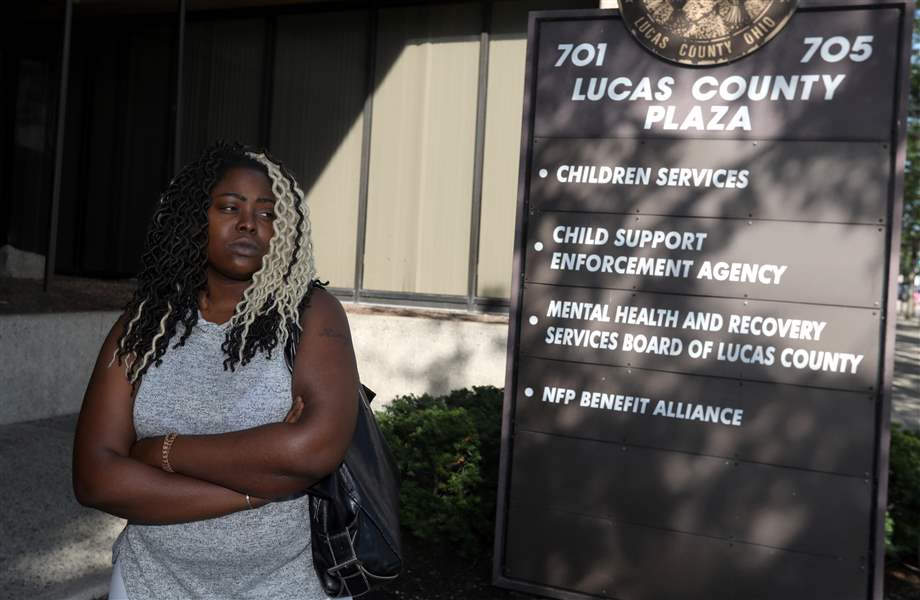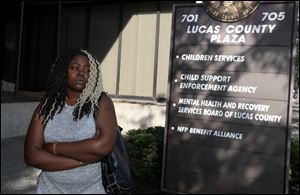
New law will overhaul Ohio's child support system
7/22/2018
Toledoan Alexisjoy Haynes is trying to get child-support payments set up to her take care of her 4-year-old child.
THE BLADE/LORI KING
Buy This Image

Toledoan Alexisjoy Haynes is trying to get child-support payments set up to her take care of her 4-year-old child.
Alexisjoy Haynes has two kids, ages 4 and 14, to feed.
Ms. Haynes, a 34-year-old Toledo resident who works as a medical assistant and phlebotomist, has been trying to set child-support payments for her 4-year-old to make it easier to pay her grocery bills, which can spike when her children are hungry.
But in Ohio consistent child support payments are no guarantee, especially in cases involving low-income noncustodial parents. Statewide, only 30 percent of families due child support payments of $75 or less a month receive payments at all, in part because the support system sets orders too high for low-income payers, experts said.
Missed payments can make it hard for custodial parents to afford child care, clothes, and other necessities, and the children whom the payments are intended to benefit may suffer. But a new law overhauling the state’s child-support system aims to ensure parents have the resources they need to care for their children.
Ms. Haynes hopes the change will help people like her receive the money they’re owed.
“It’ll help just knowing money’s coming in,” she said at the Lucas County child support office on a recent weekday. “Anything helps, especially on a constant basis.”
■ Updates economic tables used to calculate orders for first time since 1992.
■ Establishes “self-sufficiency” reserve, lowering orders for low-income payers.
■ Increases minimum order from $50 to $80 per month.
■ Provides for calculation of orders for families with combined income up to $300,000.
■ Takes health-care coverage and medical expenses into consideration.
■ Accounts for shared parenting time.
■ Caps support payments at half of child-care costs.
■ Allows Department of Job and Family Services to update economic tables, rather than requiring lawmakers to.
The bill, signed by Gov. John Kasich in late June and set to take effect in April, updates the antiquated economic tables used to calculate child-support orders, which have not been updated since 1992. It also introduces a “self-sufficiency reserve” — an adjustment made to payment requirements of low-income parents to ensure they can meet their obligation — based on 116 percent of the federal poverty level.
“We’re going to get payments to the obligees, and we’re going to get people in a position where they’re not accumulating a huge [debt],” said state Rep. Theresa Gavarone (R., Bowling Green), who sponsored the bill in the House. “The children are going to be the ones who benefit from this.”
In approximately one third of Lucas County child support cases, no payments have come in, said Michelle Niedermier, director of the Lucas County Department of Job and Family Services. About $150 million in child-support orders have gone unpaid in the county in the last five fiscal years.
“People just avoid the system because it’s such an issue,” Ms. Niedermier said. “It can only go in the positive direction.”
Lucas County residents Brandyn Fulton and Ted Keil, both noncustodial parents who pay child support, said their orders are set too high.
Since he lost his job assembling and packing chairs for MTS Seating, a furniture manufacturer in Temperance, Mich., Mr. Fulton, 26, of Toledo said he’s fallen about $2,500 behind on his payments.
On a good week, Mr. Fulton pulls in $400 hanging wallpaper and working other side jobs, about half of which goes to child support. He said he’s having trouble paying off his debt, and he recently received a letter from the Lucas County Child Support Enforcement Agency informing him that his driver’s license would be suspended.
VIDEO: Brandyn Fulton
Mr. Keil, 46, of Oregon is a truck driver for Transport Leasing/Contract Inc. He recently found out his child-support bill would rise from $300 to $700 a month.
“$700 a month is a house payment,” Mr. Keil said. “I can make it, but I’m not going to have enough for my own bills.”

Oregon resident Ted Keil looks over his paperwork before his child-support hearing at Lucas County Child Support Services in Toledo.
While the new law is intended to make payments more realistic for noncustodial parents, some Ohio attorneys are concerned the self-sufficiency reserve for low-income payers decreases payments too much and could jeopardize the financial stability of custodial parents and their children.
“There are studies that show the higher the order, the more the obligor is going to pay,” said Natasha Plumly, a senior staff attorney with Southeastern Ohio Legal Services. “I do think [the bill] will benefit some obligors who are truly willing to pay but just can’t, but I think this almost oversimplifies why obligors don’t pay.”
Last fall, the Ohio Poverty Law Center proposed 10 amendments to the child-support overhaul bill, including one that keep orders for low-income payers slightly higher and another that would remove a cap on the amount of child-care expenses for which payees can receive credit. None of the amendments was incorporated.
However, Amy Roehrenbeck, executive director of the Ohio Child Support Enforcement Agency Directors’ Association, said the payment reductions encased in the new law will enable low-income payers to meet their payments on a regular basis.
“Right now, the methodology that we use tends to inflate the available income on the low-income end,” she said. “We’ve got 30 years of evidence showing that how we’ve been doing it isn’t working.”
Ms. Roehrenbeck noted that the bill will apply to new child-support orders or cases where people qualify to have their orders adjusted but will not retroactively alter existing orders.
The bill introduces other significant changes to the state’s child-support guidelines.
To account for the rising costs of child care, the legislation increases the minimum order to $80 a month, up from $50. It also takes into consideration parent contributions for health-care coverage and medical expenses, and extends the economic tables to calculate orders for families with a combined income of $300,000, double the current limit.
Ms. Plumly expressed concern that a shared-parenting provision introduced in the bill, which reduces payments for noncustodial parents who take on child-care responsibilities, could lead to increased litigation over the amount of time each parent spends with the child.
“This is going to make custody a more difficult discussion for parents,” she said. “It’s sort of taking the focus away from the kids and putting it on the money.”
But state Sen. Bill Beagle (R., Tipp City), who sponsored the bill in the Senate, said he supports this provision.
“In the last 25 years, we’ve seen more shared parenting, but our tables and our math don’t reflect that,” said Mr. Beagle. “If you have a right-sized order that better reflects how parenting is done in modern times, you might improve your collection rate.”
In another key change, the legislation moves the economic tables from the revised code to the administrative code, placing them under the jurisdiction of the Ohio Department of Jobs and Family Services, rather than the legislature. The department will review the payment guidelines every four years and update them if needed.
“This won’t get bogged down in the political dogfights that have been holding up these updates,” Mr. Beagle said.
Contact Mark Rosenberg at mrosenberg@theblade.com, 419-724-6194, or on Twitter @markrosenberg32